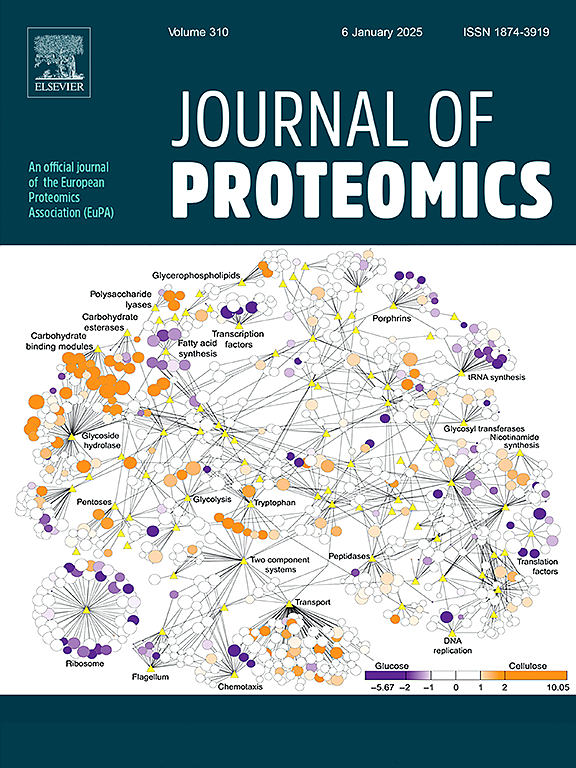tmt标记比较蛋白质组学揭示武菜(Brassica campestris L.)春化机制
IF 2.8
2区 生物学
Q2 BIOCHEMICAL RESEARCH METHODS
引用次数: 0
摘要
探讨武菜(Brassica campestris L.)春化的分子基础。基于串联质量标签(tandem mass tags, TMT)的方法进行了差异蛋白质组学分析。对春化0、15和30天(V0、V15和V30)的茎尖进行蛋白质分析,以鉴定差异丰富蛋白(DAPs)。共获得8066个蛋白,其中507个共享dap参与春化的起始和进展。基因本体论(GO)和京都基因与基因组百科全书(KEGG)注释揭示了细胞过程、代谢途径和翻译相关活动的功能富集,包括光合作用、硫代葡萄糖苷生物合成和类黄酮生物合成。蛋白质组学数据显示,春化过程中光合作用相关蛋白丰度降低,类黄酮生物合成上调。24个蛋白在代谢和调控途径上的转录验证证实了蛋白质组学的发现,在春化15天与类黄酮生物合成相关的基因,如VESR1、CH13、CHS1、FHT和FLS1,出现了显著的峰值。这些基因在春化中的功能将被进一步分析。意义白菜在寒冷条件下易过早抽苔和开花,春化对白菜的开花时间起着关键的控制作用。然而,春化的蛋白质组学基础仍然知之甚少。在这项研究中,基于tmt的蛋白质组学分析鉴定了与春化相关的DAPs。通路富集分析突出了关键DAPs及其在春化相关的显著富集通路中的作用。值得注意的是,类黄酮生物合成途径基因中的基因,包括VESR1、CH13、CHS1、FHT和FLS1,都对春化有反应。这些发现为研究武菜花期调控的分子机制提供了新的思路。本文章由计算机程序翻译,如有差异,请以英文原文为准。

TMT-label comparative proteomics reveals the vernalization mechanism in Wucai (Brassica campestris L.)
To investigate the molecular basis of vernalization in Wucai [Brassica campestris L. (Syn. Brassica rapa L.) ssp. chinensis var. rosularis Tsen], we performed differential proteomic analysis using a tandem mass tags (TMT)-based approach. Proteins from shoot apices subjected to 0, 15, and 30 days of vernalization (V0, V15, and V30) were analyzed to identify differentially abundant proteins (DAPs). A total of 8066 proteins were obtained, and 507 shared DAPs were involved in both initiation and progression of vernalization. Gene Ontology (GO) and Kyoto Encyclopedia of Genes and Genomes (KEGG) annotations revealed functional enrichment in cellular processes, metabolic pathways, and translation-related activities, including photosynthesis, glucosinolate biosynthesis, and flavonoid biosynthesis. Proteomic data showed reduced abundance of photosynthesis-related proteins and upregulation of flavonoid biosynthesis during vernalization. Transcriptional validation of 24 proteins across metabolic and regulatory pathways corroborated proteomic findings, with notable peaks in genes associated with flavonoid biosynthesis at 15 days of vernalization, such as VESR1,CH13, CHS1, FHT, and FLS1. The functions of these genes in vernalization will be further analyzed.
Significance
Wucai is prone to premature bolting and flowering under cold conditions, as vernalization plays a key role in controlling flowering time in Chinese cabbage crops. However, the proteomic basis of vernalization remains poorly understood. In this study, TMT-based proteomic analysis identified DAPs associated with vernalization. Pathway enrichment analysis highlighted key DAPs and their roles in significantly enriched pathways relevant to vernalization. Notably, genes in the flavonoid biosynthesis pathway genes, including VESR1, CH13, CHS1, FHT, and FLS1, respond to vernalization. These findings offer novel insights into the molecular mechanisms underlying flowering time regulation in Wucai.
求助全文
通过发布文献求助,成功后即可免费获取论文全文。
去求助
来源期刊

Journal of proteomics
生物-生化研究方法
CiteScore
7.10
自引率
3.00%
发文量
227
审稿时长
73 days
期刊介绍:
Journal of Proteomics is aimed at protein scientists and analytical chemists in the field of proteomics, biomarker discovery, protein analytics, plant proteomics, microbial and animal proteomics, human studies, tissue imaging by mass spectrometry, non-conventional and non-model organism proteomics, and protein bioinformatics. The journal welcomes papers in new and upcoming areas such as metabolomics, genomics, systems biology, toxicogenomics, pharmacoproteomics.
Journal of Proteomics unifies both fundamental scientists and clinicians, and includes translational research. Suggestions for reviews, webinars and thematic issues are welcome.
 求助内容:
求助内容: 应助结果提醒方式:
应助结果提醒方式:


